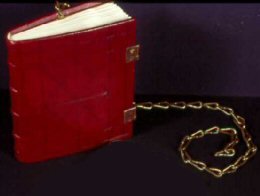Home
Qualifications
Services
Noteworthy
Projects
Shipping
Information
Some Tips
on Book &
Document
Care
Contact
Legacy
 |
Some Tips on Book &
|
|
In addition to my little brochure on care and handling of books and documents (find it here as a PDF file), Iíd like to offer some other general thoughts for anyone who is interested in preserving their books, valuable or not. Without repeating what I have to say in my brochure too much, I want to emphasize that storage and handling really are the biggest factors in the survival of your books and documents. Leave your books in a box in the basement, and youíre just asking for mold damage. Likewise, leave them sitting in direct sunlight, and they'll suffer UV damage (fading, accelerated aging...). Do 'repairs' yourself with tape, and they'll not only not be repaired, but any future real repair will be more time-consuming and hence more costly, if it can be done at all. On the other hand, if you keep your books stored properly on bookshelves (either standing upright as is now the practice, or on their side stacked up as was common until a couple hundred years ago), out of direct sunlight, in your main living space (your books will be comfortable in the same temperature and humidity range that you are), then youíre doing yourself (and your heirs) a favor. Now, that said, there are some other items that you might want to know. Many people think that putting neat's-foot oil on their leather bindings will help preserve them. Not true. Research has shown that about the only thing this does is run the risk of the oil soaking into the paper of the text block, ruining it. There are some commercial leather dressings designed for book leather, but any of them which contain oil of one sort or another should be avoided by non-conservators. If you want to put something on your leather bindings, I recommend Hewit's Leather Cleaning & Preservative Wax. It comes in a liquid form, is easy to use, hard to over-do, and can be found online at TALAS. Have your books properly shelved? Do you know the correct way to take a volume off the shelf? If you hook a finger over the top of the exposed spine and pull - well, soon youíll need me to repair that book. Because that action puts a lot of stress on the hinges of the book, and can tear the "head" of the spine loose entirely. Itís a whole lot better to push the adjacent books in, then grasp the spine of the book you want in the middle to remove it. Want to protect your personal bible? Do you have one of those fancy leather cases that slip onto the front and back covers, then zips closed? Well, get rid of it. Those things just put a lot of stress on the hinges, and cause the covers to tear loose prematurely. If you have one of those cases and really want to use it, just stick the book inside then zip it closed, taking the book out of the case entirely when you want to use it. Like to mark your place in a book with little pieces of paper? Think that an old family bible is the perfect place to tuck away photos, greeting cards, locks of hair or flowers? Well, think again. Any items stuck into a book this way just cause the spine to swell, and will quickly ruin the sewing structure (or separate the adhesive binding). And any vegetable matter that is in contact with the pages will cause rapid discoloration because of tannic acid and moisture. Got an adhesive price tag stuck on a favorite volume? Cigarette lighter fluid is almost pure naptha, and ideal for removing most pressure-sensitive adhesives (such as tapes, price tags, et cetera) so long as they are still sticky. Apply a little to a Q-tip, then daub that on the adhesive/tape/tag. Usually a couple of applications will loosen up the adhesive, though you may need to use a dull knife or similar implement to scrape off the residual. Now, just to be safe, always test any kind of solvent like this in some inconspicuous place, to make sure it won't cause discoloration or something. |
|


